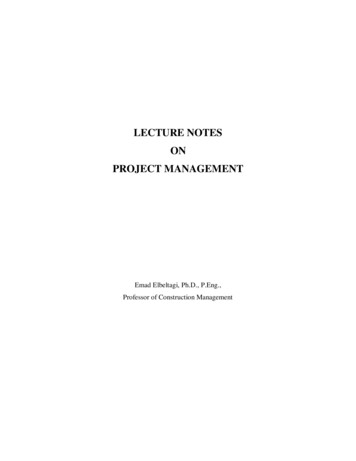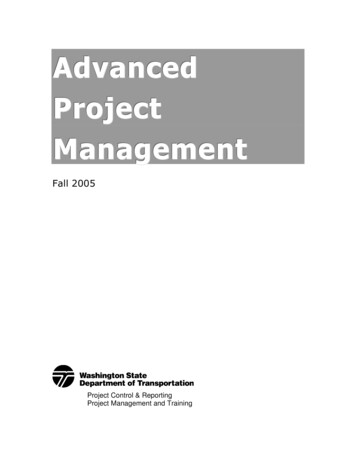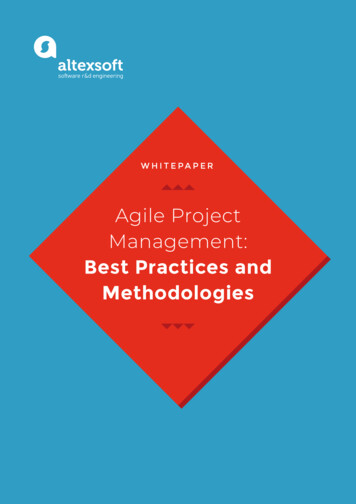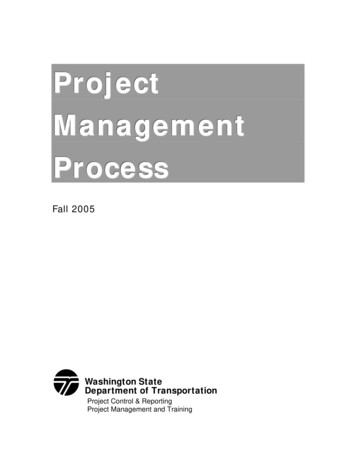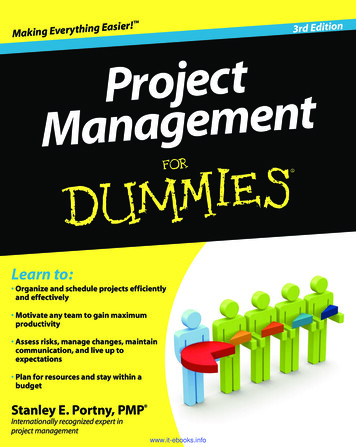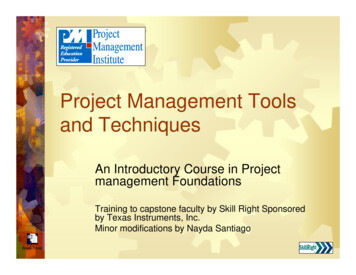
Transcription
Project Management Toolsand TechniquesAn Introductory Course in Projectmanagement FoundationsTraining to capstone faculty by Skill Right Sponsoredby Texas Instruments, Inc.Minor modifications by Nayda SantiagoBreak Timer
What Is Project Management?“Project management is the applicationof knowledge, skills, tools, andtechniques to project activities in orderto meet or exceed stakeholder needsand expectations.”expectationsSource: Project Management InstituteBreak Timer
Benefits of ProjectManagementEnables completion of projects in the shortesttime possible while balancing cost and quality Enhances staffing flexibility and can helpaccomplish more work with fewer resources Provides timely information to multiple levelsof the organization in consistent formats Enhances decision making based on factsand project information Enhances ability to achieve businessobjectives and goals Break Timer
What Is a Project?“A project is atemporary endeavorundertaken to createa unique product orservice.”serviceSource: PMIBreak Timer
Project Characteristics Hasa goal/meets a need Is a set of related activities that are nonrecurring Has a definite beginning and end Has clearly defined goals anddeliverables Consumes resources Needs to be managedBreak Timer
Project Manager“The person who is responsible for theproject and will be held accountable forits success or failure.”Break Timer
The Triple ct ScopeScheduleBreak Timer
Balancing the “ProjectSuccess Triangle”A clearunderstanding ofcustomer priorities “People” skills Thorough planning An organized,structured process Break Timer
Project Management ProcessSource: PMBOKInitiationPlanningExecutionBreak TimerTo help guide youthrough the processyou need aroadmap of sometype ControlsCloseout
Roadmap to Project Management SuccessStatementof sponsibilityMatrixRProject BackgroundGanttNetworkResourcePlanBudgetAAProject DeliverablesSSRTIMEPROJECTGSBreak TimerEvaluateSuccessPerformTasksLEADERSHIPEN nedOBOOKETETNPLANELIM PUpdatePlanResolveIssuesManageChange
Goals of the ProjectManagement Roadmap Meetcustomer expectations. Work within organizational constraints. Continuously improve the process. Control the cost of ChangeBreak Timer
The Cost of ChangeCost of ChangeProject ak TimerProject Phases
Project Stakeholders What Ifis a project stakeholder?you can gain or lose from thesuccess or failure of a project, youhave a “stake” in the project.Break Timer
Key Project Stakeholders Customer/client Projectsponsor Project manager Project teamBreak Timer
Project Manager Break TimerDefine and managecustomer expectations.Coordinatedevelopment of theproject plan.Monitor and controlproject work accordingto the approved plan.Communicate projectstatus by preparingstatus reports andconducting progressreview meetings. Establish and follow achange managementprocess.Lead the project teamand resolve conflictsbetween teammembers.Maintain the projectnotebook.Conducting projectclose-out activities.
Project Manager SkillsLeadership Communications Organizing Negotiating Managing conflict Motivating Controlling Team building Planning Directing Problem solving Coaching Delegating Supporting The skill set for a good general manager!!Break Timer
Project Team Members Break TimerIdentify work tasksEstimate the duration ofwork tasksHelp prepare the projectnetwork diagramHonestly report workstatusKeep the projectmanager informed onproject issues Attend scheduledprogress reviewmeetingsRaise issues importantto the project’s successKeep their functionalmanagers updatedParticipate in the projectclose-out
Break Timer
The Project TeamHow are project teams formed?Careful selection process?Luck of the draw?Break TimerTeam selection and the strength of theteam depends on the company’stype of Project Organization!
Organizational BreakdownStructure (OBS)ProjectManagerCivilEngineeringBreak tration
Roadmap to Project Management SuccessPurposeResponsibilityMatrixStatementof WorkProject BackgroundRASSRTIMEPROJECTOBOOKETMEETNProject BackgroundGSLEADERSHIPBreak formTasksINProject essonsLearnedResourcePlanAProject DeliverablesConductClose-OutMeetingGanttNetworkEN EMStatementof WorkELIM PUpdatePlanResolveIssuesManageChange
Why Plan?“The nicest thing about not planning isthat failure comes as a completesurprise and is not preceded by a periodof worry and depression.”John Preston, Boston CollegeBreak Timer
Project Plan Contents Break TimerStatement of work(SOW)Work breakdownstructures (WBS)Responsibilityassignment matricesProject scheduleResourceplans/histogramsBudget Risk management planCommunications planQuality planVerification andvalidation plan
Project Plan BenefitsProvides an effective communication tool toensure understanding of project goals andthe means to achieve them Defines outcomes and commitments Establishes guidelines and standards Establishes the baseline for evaluating andreporting progress Forms the basis for scope control and changemanagement Break Timer
Project Notebook Project Pre-plan Statement of Work (SOW)Work Breakdown Structure (WBS)Organization/responsibility chartsSchedule dataBudget/capital planRisk managementProject Implementation Break TimerBackground informationCustomer dataThird-party data (vendors, suppliers,etc.)Meetings y progress reportsCustomer change requests/decisionmatrix issue resolution forms/reportsProject Close-out Project Plan Final evaluation of measurablesuccess indicatorsClose-out meeting(agenda/minutes)Final project reportReference lettersLessons learnedProject Administration Contractual documentsInvoicesExpensesCorrespondenceContact log
Statement of Work — Purpose Definethe scope of the project Establish customer expectations Serve as a “contract” if necessaryBreak Timer
A Good SOW will answer Whatis the purpose or goal of theproject? Why is the project being done? Who is the initial customer? Who is the end user or final customer? What are the customer deliverables? What technical support is required forthe deliverables?Break Timer
And continue to answer Whatis the budget? What is the final date for thedeliverables? What are the measurable successindicators (metrics)? What kind of support is required fromthe customer? What contingency plans are in place?Break Timer
SOW — Generic ContentsCustomer Project Title Purpose Background Deliverables Measurable success indicators Customer support Risk plans Break Timer
Statement of Work - Page 1STATEMENT OF WORKDate:Form completion dateContributors:People who helped write thestatement of workPerson or organizationrequesting the workImmediate Customer:Person or organization who willFinal End User: use the results of the projectPROJECT TITLE:The project title should be a short, concise statement that defines the project.PURPOSE:The purpose of the project is the goal; why you are doing the project. This should be clearly stated.Break Timer
PROJECT BACKGROUND:The project background should contain information pertaining to the history of the project.It also includes a statement that justifies the project. For a first draft, brief statements are acceptable. Formal statements of workare usually in paragraph form. Supply information that explains the philosophy behind the project. Alsodescribe what makes the project unique/special. This information can be used later to:– Leverage resources– Accommodate management directives– Gain support from external– Accommodate changesorganizations/departmentsMany of the statements made in the background section must be substantiated in themeasurable success indicators section of the statement of work.The project background includes the following key elements: History Consequences Justification Uniqueness of projectSome examples on the type of information to include in the project background sectioninclude: Meet safety requirements Support business plan Meet quality requirements Meet customer expectations Improve performance/efficiencyBreak Timer
DELIVERABLES:Deliverables are the outputs of the project. They are what is promised to thecustomer. Deliverables are written as nouns. They are things. Quantities must be identified in this section. Include the major elements of the deliverables.It is important to be very clear in the deliverables section. Misinterpretation ofproject deliverables can establish incorrect customer expectations.The following are examples of deliverables: Parts Test results Prototypes Training Procedures Specifications Equipment Technical drawings Installation of equipment Plans Written reportsBreak Timer
STATEMENT OF WORK (Page 2)MEASURABLE SUCCESS INDICATORS:Measurable success indicators include concise, measurable, information that will be used todetermine if a project was successful. Measurable success indicators must substantiate anystatements made in the background section.Include what is known about quality, cost, and schedule expectations.ScheduleQualitytosCExamples of measurable success indicators include: Complete project in three months Reduce mass by 30% Complete ROI for initial expenditure by Nov. 30, 20xx Achieved 1.00 reduction in piece cost Demonstrate meeting of EPA Standard # xxxx New process will require two fewer operators Stay within budget of 275,000.00Two specific measurable success indicators which are most important in terms of seeing the“big picture” of a project are: Overall schedule BudgetIt’s also important to note any key milestone dates that have been established.“SMART” is an acronym used to help write good measurable success indicators for a project.The words which comprise the acronym SMART are: Specific Realistic Measurable Time (cost) framed Agreed uponBreak Timer
Smart Measurable SuccessIndicators (SMART)S - SpecificM - MeasurableA - Agreed uponR - RealisticT - Time and cost framedBreak Timer
CUSTOMER SUPPORT:The customer support area provides a means to list the items and services that must beprovided by the customer/sponsor to ensure the success of the project. Examples include: Drawings Subject matter experts Equipment Computer time Photocopying Phone/secretarial supportPROJECT RISK PLANS:The last section of the statement of work is the risk plan. Risk plans consider the possibility ofan event occurring that would drastically alter the schedule, budget, or quality of the project. Identify what is likely to go wrong, and also what can have the most impact. Ask “What can go wrong?” “How will I handle it?” Put your statements in “If , then .” formatExamples of risk plans are: If a labor strike occurs, then outsource production. If supplier cannot ship materials in time, then contact another vendor. If design freeze date is not maintained, then use current product design.Break Timer
ExercisePrepare a Statement of WorkBreak Timer
Roadmap to Project Management TIONNSOEvaluateSuccessSRLESEOSCLBreak TimerASOShareLessonsLearnedBudgetAProject DeliverablesConductClose-OutMeetingResourcePlanEN TSTPurposeProject Statementof WorkELIM PUpdatePlanResolveIssuesManageChange
Work Breakdown Structure—Purpose Identifyall of the work that needs to bedone to complete the project. Structure the work into logicalcomponents and subcomponents. Define the work to a level of detail soindividual responsibilities can beassigned. Summarize and report project data.Break Timer
Representative WorkBreakdown StructureTITLELevel I(Noun)DELIVERABLEPHASELevel II(Noun)ACTIVITYLevel III(Action Verbs)Level IV(Action Verbs)Break TimerTASK(WORK PACKAGE)ACTIVITYTASK(WORK PACKAGE)FUNCTION"CHUNK" OFWORKPROJECTMANAGEMENT
Automotive WBSLevel 1Building a rk PackagesBuildTestBreak TimerElectricalTransmissionOil PanLevel 2Level 3Level 4Level 5
WBS Work Package –Level of Detail WHO willbe the responsible individualor organization? How much TIME will the activity take? What COST is associated withaccomplishing the activity? Can PROGRESS be tracked easily?Break Timer
WBS — Outlining ApproachI. Main Project DeliverableA. Major Element1. Activity2. Activitya. taskb. taskc. task3. ActivityB. Major Element1. Activity2. ActivityBreak Timer3-4-10Level 1Level 2Level 3Level 4Level 3Level 2Level 3The outlineapproach isused byMicrosoft Project
ExerciseCreate a WBSBreak Timer
Roadmap to Project Management trixProject LCOMMUNICATIONOShareLessonsLearnedBreak esourcePlanAProject DeliverablesRGanttNetworkEN EMStatementof WorkELIM PUpdatePlanResolveIssuesManageChange
Responsibility AssignmentMatrix (RAM) — Purpose Ensurethat all tasks are assigned topeople Show levels of involvement of people toworkBreak Timer
SUPPORTSTAFFSENIORMANAGEMENTTEAMMEMBERMARKETING STUDYCUSTOMERRASIC MethodPROJECTMANAGERResponsibility AssignmentMatrixSRRSIRISITEST SURVEY ON SAMPLERISFINALIZE SURVEYRASISCONDUCT SURVEYRISISCOLLECT SURVEYRISIDENTIFY POTENTIAL MARKETCIDENTIFY SURVEY POPULATIONCDEVELOP SURVEYSLEGENDR - RESPONSIBLEA - APPROVES - SUPPORT (DOES THE WORK)I - INFORMC - CONSULTBreak TimerREPORT RESULTS AND SUGGESTIONIR/SANALYZE DATARASAS
RASIC Coding System R Responsible A Approve Is kept informed of work status, no decision makingC Consult Break TimerDoes the work. Committed to its completionI Inform Approves that the work meets all requirements.S Support Ensures that the assigned work is completed, responsible forthe delivery.Is consulted on the work. Provides input.
Roadmap to Project Management SuccessStatementof WorkFormProjectTeamPurposeProject BackgroundProject kRTIMEPROJECTGSBreak TimerEvaluateSuccessPerformTasksLEADERSHIPEN nedOBOOKETETNPLANELIM PUpdatePlanResolveIssuesManageChange
Project Schedule — Purpose Determineif requested completion dateis possible. Identify start and completion dates of allwork. Determine the controlling sequence ofactivities. Provide data for resource allocation. Track progress by providing a baseline.Break Timer
SchedulingStep 1: Estimate Activity DurationsStep 2: Determine Activity Sequence By Creating aNetwork DiagramStep 3: Calculate the Schedule Using Critical PathMethod (CPM) ProceduresStep 4: Show the Schedule by Drawing Gantt and/orMilestone ChartsBreak Timer
Estimate activity duration Expert judgment Analogous estimating Individuals who have performed similar activities.Use similar projects to estimate this one.Three point estimate (PERT – project evaluation andreview technique)estimate Break Timerpessimistic (4 times realistic) optimistic6
WBS/Network DiagramLinkageabcbaBreak Timerdedefghijihcfgj
Network Diagram MethodsCABJDHBreak TimerBDPrecedence DiagramMethodGIJCAFEArrow Diagram MethodEFHIG
Precedence Diagram MethodEABFCGDHLogic ConnectionBreak TimerActivityIJ
What’s is the Critical Path? Path with least slackPath with longest durationCritical Path Method is a project managementtechnique that analyzes what activities have the leastamount of scheduling flexibility (i.e., are the mostmission-critical) and then predicts project durationschedule based on the activities that fall along the“critical path.” Break TimerActivities that lie along the critical path cannot be delayedwithout delaying the finish time for the entire project.
Project X — Critical PathSolutionE2437B1120Break TimerA022 03947F133436C0325Activity NameFloatDurationES EF LS LF2522D513 755G027 57H38516897I029 7J0199 10910
Enhanced Gantt ChartJanFebMarAprilMayJuneTask ATask BTask CTask DTask ETask FBreak Timer- Critical- Non-Critical- Slack/Float
Project X — Gantt ChartSolutionTimeActivityBreak Timer123456789DurationA2B1C3D1E4F3G2H1I2J1- Critical- Non-Critical- Slack/Float10
Exercise Break TimerPrepare a projectschedule for yourproject.
Roadmap to Project Management SuccessStatementof sponsibilityMatrixRProject BackgroundASSResourcePlanResourcePlanAProject DeliverablesGanttNetworkRBudgetTIMEPROJECTGSBreak TimerEvaluateSuccessPerformTasksLEADERSHIPEN nedOBOOKETETNPLANELIM PUpdatePlanResolveIssuesManageChange
Assigning ResourcesA schedule is not complete until all theresources necessary to complete theproject have been committed or assigned.Break Timer
Factors to Consider Availabilityof other resources Depletion of available float time Impact on critical path Impact on budgetBreak Timer
Non-Labor Resources Labtime Facilities Prototype parts/systems Equipment MaterialsRoadmap to Project Management SuccessStatementof sponsibilityMatrixRProject Project gressPEOSCLSCOMMUNICATIONLO EARNEDUTEvaluateSuccessMELEADERSHIPNSOLESBreak TimerOOKEBM ange
Roadmap to Project Management SuccessStatementof sponsibilityMatrixRProject BackgroundResourcePlanGanttNetworkBudgetAAProject DeliverablesSSBudgetRTIMEPROJECTGSBreak ProgressTIMEPORCOMMUNICATIONEN ngShareLessonsLearnedOBOOKETETNPLANELIM PUpdatePlanResolveIssuesManageChange
Estimating costs The costs of a project are derived from theWBS, schedule, resources, and risks.Include Break TimerLaborEquipment–remember S/HSupplies –remember S/HMaterials–remember S/HTravelTrainingOverheadContingency planSource: PMI
Roadmap to Project Management SuccessStatementof sponsibilityMatrixRProject BackgroundGanttNetworkResourcePlanBudgetAAProject DeliverablesSSRTIMEPROJECTGSBreak TimerEvaluateSuccessPerformTasksLEADERSHIPEN nedOBOOKETETNPLANELIM PUpdatePlanResolveIssuesManageChange
What Is Risk?Risk can be defined as:“Any threat to project success.”Break Timer
WithinAvailableResourcestyaliQuCostProject ScopeScheduleProject RiskBreak Timer
Risk Management“Risk Management is the art andscience of identifying, analyzing andresponding to risk factors throughoutthe life of the project and in the bestinterests of its objectives.”Source: PMIBreak Timer
Risk Plan kMonitoringResponseDevelopmentBreak Timer
Prioritizing & PlanningProbability of Occurrence100%PRIORITY 2 RISKS(High Probability)(Low Impact)Reactive MeasuresPRIORITY 1 RISKS(High Probability)(High Impact)Proactive and ReactiveMeasuresPRIORITY 3 RISKS(Low Probability)(Low Impact)Monitor OnlyPRIORITY 2 RISKS(Low Probability)(High Impact)Reactive Measures50%0%LowMediumHighNegative Impact on Scope/Quality/Cost/Schedule(Risk Event Value)Break Timer
End of Planning PhaseBreak Timer
Project Management ProcessSource: oject ImplementationBreak Timer
Roadmap to Project Management SuccessStatementof sponsibilityMatrixRProject BackgroundGanttNetworkResourcePlanBudgetAAProject DeliverablesSSRTIMEPROJECTGSBreak TimerEvaluateSuccessPerformTasksLEADERSHIPEN nedOBOOKETETNPLANELIM PUpdatePlanResolveIssuesManageChange
Implementation ModelStep 1Perform TasksStep 4Update the PlanResolveIssuesStep 3Manage ChangeBreak TimerStep 2Track Progress
Roadmap to Project Management SuccessStatementof sponsibilityMatrixRProject BackgroundGanttNetworkPerformTasksAAProject k TimerEvaluateSuccessPerformTasksLEADERSHIPEN nedOBOOKETETNPLANELIM PUpdatePlanResolveIssuesManageChange
Reporting Project Progress Progressreview meeting Project reportsBreak Timer
Project Progress ReviewMeetingsReview of action items from last meeting Update on activities and schedule Problem identification and corrective actionplanned Review of issues (closed, open, new) Change request status Risk status Plan for next period Break Timer
Roadmap to Project Management SuccessStatementof sponsibilityMatrixRProject BackgroundGanttNetworkResourcePlanAAProject ccessMELEADERSHIPEN SEOSCLOTrackProgressINConductClose-OutMeetingBreak TimerOTOKEB OETNPLANShareLessonsLearnedBudgetELIM PUpdatePlanResolveIssuesManageChange
Project Tracking and ControlStep 1Perform TasksStep 4Update the PlanResolveIssuesStep 3Manage ChangeBreak TimerStep 2Track Progress
Compare Progress to Plan Qualityreviews Gantt schedule performance charts Cost performance chartsBreak Timer
Cost PerformanceBreak TimerWeekPlanned ValueActual Costs1 3,000 8,0002 6,000 16,0003 18,000 30,0004 30,000 48,0005 44,000 66,0006 54,0007 64,0008 80,0009 83,00010 89,000
Cost Performance Chart 100Total Costs (X1000) 90 80 70 60 50 40 30 20 10 eak Timer
Roadmap to Project Management SuccessStatementof sponsibilityMatrixRProject BackgroundResourcePlanGanttNetworkBudgetAAProject DeliverablesSSRTIMEPROJECTGSBreak NEDRETrackProgressMSPORCOMMUNICATIONEN ngShareLessonsLearnedOBOOKETETNPLANELIM PUpdatePlanResolveIssuesManageChange
Managing Project ChangeStep 1Perform TasksStep 4Update the PlanResolveIssuesStep 3Manage ChangeBreak TimerStep 2Track Progress
Categories of Change Customer Typically Allrequestedthe largest source of changeothers Internalcompany requests Government regulation Team membersBreak TimerChanges
Addressing Project ChangesCall a team meeting. Explain what the change is. Obtain feedback from team members. Identify alternative corrective options. Prepare a decision matrix. Select a recommended option(s). Present information to uppermanagement/customer. Implement the approved course of action. Break Timer
Roadmap to Project Management SuccessStatementof sponsibilityMatrixRProject ject DeliverablesSSRTIMEBreak suesLEUTARNEDREMSTrackProgressPORCOMMUNICATIONEN ngShareLessonsLearnedOBOOKETETNPLANELIM PUpdatePlanResolveIssuesManageChange
Issue Resolution Disagreements Documented Assigned Scheduled Tracked Escalated ResolvedBreak Timerthat should be
Roadmap to Project Management SuccessStatementof sponsibilityMatrixRProject ject DeliverablesSSRTIMEPROJECTUpdatePlanGSBreak ogressMSPORCOMMUNICATIONEN ngShareLessonsLearnedOBOOKETETNPLANELIM PUpdatePlanManageChange
Plan UpdatesStep 1Perform TasksStep 4Update the PlanResolveIssuesStep 3Manage ChangeBreak TimerStep 2Track Progress
Project Management ProcessSource: oseoutBreak Timer
Roadmap to Project Management SuccessStatementof sponsibilityMatrixRProject BackgroundGanttNetworkResourcePlanBudgetAAProject DeliverablesSSRTIMEPROJECTGSBreak TimerEvaluateSuccessPerformTasksLEADERSHIPEN nedOBOOKETETNPLANELIM PUpdatePlanResolveIssuesManageChange
Project Manager’s RoleDuring Project Close-OutEnsure that all project deliverables have beencompleted and formally accepted by thecustomer. Determine if the measurable successindicators were achieved. Conduct project close-out meetings, bothinternal and external. Write the final project report. Document and share lessons learned. Break Timer
Roadmap to Project Management SuccessStatementof sponsibilityMatrixRProject BackgroundGanttNetworkResourcePlanBudgetAAProject DeliverablesSSRTIMEPROJECTGSBreak TimerEvaluateSuccessEN PLANELIM PUpdatePlanResolveIssuesManageChange
Evaluating Project Success Projectpurpose Deliverables Measurable success indicators Quality Schedule CostBreak Timer
Roadmap to Project Management SuccessRConductClose-OutMeetingProject EOSCLBreak sourcePlanAProject DeliverablesConductClose-OutMeetingGanttNetworkEN BreakdownStructureLEUTARNEDREMStatementof WorkELIM PUpdatePlanResolveIssuesManageChange
Informal Project Team CloseOut MeetingBrainstorm to identify what went right with theproject. Brainstorm to identify what went wrong withthe project. List ideas for improvements. List ideas for ensuring that what went righthappens again. Recognize the accomplishments ofindividuals. Break Timer
Close-Out Meeting AgendaReview project statement of work. Review actual deliverables and show howproject met its measurable successindicators. Summarize what was done well. Identify areas for improvement. Request recommendations for improvement. Determine if any additional tasks are requiredto complete the project. Break Timer
Close-Out Meeting Agenda(continued) Listadditional tasks, responsiblepersons, and due date. Document lessons learned for theproject notebook. Discuss the project notebook availabilityto appropriate personnel for futureprojects. Evaluate subcontractor performance.Break Timer
Roadmap to Project Management SuccessStatementof sponsibilityMatrixRProject BackgroundGanttNetworkResourcePlanBudgetAAProject DeliverablesSSRTIMEPROJECTPerformTasksINGSBreak TimerEvaluateSuccessMELEADERSHIPEN tMeetingShareLessonsLearnedNPLANELIM PUpdatePlanResolveIssuesManageChange
Sharing Lessons Learned Lessons Learned Database Continuous Improvement Recommendations Break TimerCategorized electronic project informationdatabaseProject Management ProcessFormsStandards
Roadmap to Project Management SuccessStatementof sponsibilityMatrixRProject BackgroundGanttNetworkResourcePlanBudgetAAProject DeliverablesSSRTIMEPROJECTGSBreak TimerEvaluateSuccessPerformTasksLEADERSHIPEN nedOBOOKETETNPLANELIM PUpdatePlanResolveIssuesManageChange
Thank You!!!!Break Timer
What Is Project Management? “Project management is the application of knowledge, skills, tools, and techniques to project activities in order to meet or exceed stakeholder needs and expectations

